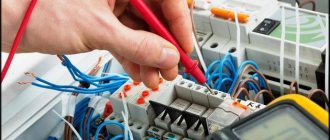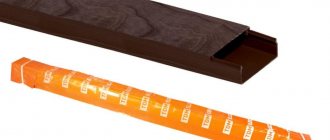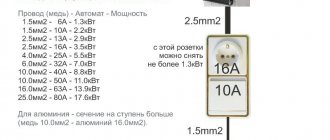Hiding wires in the wall
At the renovation stage, you can hide the wires from the TV in the wall. To do this, you need to accurately determine the permanent place of “residence” for the television panel.
Next, starting from the intended location of the wire, make a channel in the wall towards the electrical point and lay the cable. Use special construction staples to securely fix it, and then carefully cover it with plaster. Now you can start finishing work.
This method has one significant drawback - the television panel loses its mobility. If you need to move it to another location or send it in for repairs, removing the wire will be very problematic.
Hiding wires from TV and computer
Usually the TV is placed in plain sight, so the long cable from the equipment will also be visible to everyone. Most often, during repairs, they immediately determine a place for the TV, installing sockets behind it, and leading the wire out of the wall. It is recommended to carefully peel off the wallpaper, make a groove for the wiring, place it in the hole, drowning it in the corrugation. The wires are fastened using brackets.
There are almost always a lot of cables near the computer desk, because printers, modems, routers and other devices are connected to the system unit. To hide the “tangle”, you can do the following:
- attach the wires to the inner surface of the table with self-tapping screws, reliable tape, and staples;
- beautifully decorate a shoe box, a plastic box, cut holes and release wiring;
- sew a fabric cover, attach it to the table top or to the back of the furniture from the inside;
- connect the cables with office clips to the furniture;
- hide the wiring in a single “hose” that will prevent confusion.
Wire as a decorative item
Make the wire that gets tangled under your feet a part of your interior, turning it into an original piece of decor. To do this, simply wrap the wire with tapes or thick rope. The main thing is that the color of the “wrapper” matches the interior palette.
Masking with a cable channel
Use a camouflage box. With its help you will hide television wires without disturbing the surface of the wall. This structure is fastened with hidden screws and liquid nails.
Today you can purchase a cable channel model that best suits the style of the room. The simplest type is an ordinary plastic box, which after installation can be covered with the same finishing material as the entire wall.
There are models lined with decorative bricks or in the form of pipes, which are ideal for interiors in loft and hi-tech styles. For classic or eco-trends, you can choose wooden or MDF models.
Cable laying procedure
TV cable wiring in an apartment can be done in two ways: open, and in cable channels or grooves.
Cable laying technology offers:
- The section located from the panel wiring to the branch into the apartment is laid in a cable channel.
Tip: Initially, the cable channel must exceed the required width, because over time you may need to install an Internet cable in an apartment or a cord for a telephone “noodle.” When connecting to the switchboard, you should make a wire without a screen covering of a minimum length, which will improve the image quality.
- From the branch, the wire is connected through F-connectors. In this case, it is better to use threaded options. The presence of an internal thread allows, if necessary, to easily remount the entire network.
- The splitter is installed. For him, an important condition is choosing the right place. In this case, it is necessary to ensure that the interior of the room is not spoiled due to the not very presentable appearance of the device. However, the device cannot be hidden far away so that it can be easily accessed.
Splitter installation
- The socket is mounted (see How to connect a television socket). It is selected for the required F-connector, which can be straight or angular.
Antenna cable installation rules
Advice: To avoid “spurious interference” on cable lines for a television signal, they must be placed as far as possible from the power lines in the apartment, and from devices and lines going to them, where there are large inrush currents: for a refrigerator, microwave, iron, washing machine cars.
- The television cable is placed in a channel with “low-current” lines, such as alarm lines, telephone lines, and the Internet.
- All lines and TV cable distribution throughout the apartment should be done in long, whole pieces.
- It is necessary to avoid crossing television cables and power lines of the electrical network, and if necessary, cross the wires at right angles.
- Installation work should be carried out with only factory-made TV signal dividers and splitters. In this case, reliable contact of the wires and shielding of the incoming signal is ensured. This is not ensured by any twisting of wires, which means there will be no high-quality signal for TV.
- Laying of cable lines must be done using a special television cable of the RK 75 brand or a special cable for digital television.
- Laying and connecting a TV cable cannot be carried out by forming a cable loop, twisting it into a coil, or with sharp bends. This will immediately lead to a deterioration in the quality of signal reproduction.
- When laying a TV cable and power line together, you need to use a TV cable with a central wire diameter of at least 1 mm, and preferably with double shielding: two layers of foil located above and below the braid.
Cable wiring in the apartment
Instructions for installing a cable into an apartment suggest:
- On the top floor of the building there is a switchboard from which many different wires run. They are marked according to their belonging to a specific apartment.
Switchboard
- The required cable is determined and stretched to the required floor.
- A small hole is drilled near the door so that the wire can be pulled through it into the apartment.
- Indoors, the cable is secured near the front door with special wall mounts.
Cable installation in an apartment
- The wiring runs from the door to the TV. Usually, for this purpose, the cable is hidden with special structures.
A complete overview of the cable laying work helps to get a video where all the steps are discussed and useful tips are given.
Hiding behind drywall
Drywall is widely used in the design of modern interiors, as it allows you to mask surface imperfections and create original decorative designs. Why not take advantage of this?
Come up with a wall structure, for example, in the form of a plasterboard box with niches, shelves and, of course, space for a television panel. After installation, all wires will be securely hidden, and the interior of the room will become more stylish and functional.
You can build a false fireplace from drywall and install a TV above it. This way you will get a great seating area, and the wires will be securely hidden.
Options for laying wires without gating
Often, new equipment is connected, leaving the wires lying on the floor or hanging on the walls. It looks unsightly, spoils the interior, and, moreover, creates the danger of equipment falling or a person tripping over scattered wires.
If a major renovation is being done in the house, then all the wires are laid in the walls - in grooves. If the house is wooden, the wires are usually hidden in protective corrugated sleeves. You can place the wires on one of the “edges” of the room - on the walls, floor or ceiling. Let's take a closer look at these options.
Floor
Sometimes you need to run wiring across the floor. This is easier to do than on the walls. If the installation is carried out after repairs, naturally no one will want to cut grooves in the cement screed. We need to look for more affordable installation methods.
The best option for laying wires on the floor without gating:
- In special skirting boards with holes. Construction stores offer a wide range of similar products. The wires are laid in the plinth, removing the removable element. After installation, the “valve” is returned to its place.
- Under laminate. To implement this option, the lamellas under which the cable will be passed are partially removed - right up to the construction joists. The wire is laid in a corrugated pipe. If necessary, space is cut into the wood for the wires to cross.
Ceiling
The choice of installation option on the ceiling depends on the type of ceiling covering. Stretch ceilings are often installed in residential premises and offices. They “eat up” excess space, but allow you to distribute them at the top as required by the electrical supply diagram.
There are no obstacles for cables on the ceiling and they can be laid there along the shortest path, this allows:
- reduce costs;
- reduce work completion time;
- reduce the overall circuit resistance;
- ensure a higher level of fire safety;
- if necessary, it is easy to replace the wires.
According to fire safety requirements, cables must be covered with corrugated pipes. The same should be done with wiring installed behind suspended ceilings, in niches or plasterboard structures.
It is recommended to connect all the wires into one trunk - this will simplify future repair work. If the ceilings are concrete, you can’t do without gating.
Walls
The cable on the wall can be placed in a decorative box - this option is especially good for large-diameter wires, since there is no way to hide them in the wall without repairs.
Other options for laying wires on the walls:
- hide in door frames;
- cover with baguettes or moldings;
- lay in the window slopes.
Please note that the last three options are only suitable for low-current wires (Internet, telephone, etc.). High voltage wires may be laid in accordance with fire safety standards.
How to hide wires in furniture
The TV can be installed in a wall set, which will hide all communications in its depths. But if you don’t like bulky structures, use modular elements, such as a wall cabinet.
Many modern models of such furniture already have special holes in their design into which wires are laid.
Stretch ceilings in the interior of an apartment (200 photos)
Wire panel
If you are a creative person, come up with some kind of wall drawing, the contours of which you will draw with wire. You can find quite a lot of such ideas on the Internet!
Draw a sketch on the wall with a pencil and start laying. Don’t forget that the pattern or geometric figure should fit harmoniously into the interior.
An important point is the method of fixation. Nails are not suitable for this work - they can damage the cable and spoil the design with their unaesthetic appearance. Therefore, use double-sided tape or glue.
Masking with vinyl stickers
Interior vinyl stickers are an excellent decorative material. Its main advantage is that it allows you to quickly transform the interior and emphasize style. At the same time, such decor can be removed or replaced with a new one at any time without any problems.
Use vinyl stickers to create decorations where the TV cable is located. It could be a branchy tree, with the crown of which the cable will blend into the color palette.
Selecting a TV cable
Wiring an antenna cable in an apartment begins with the selection of high-quality materials and equipment.
The main characteristics of the cable are:
- Length.
- Thickness.
- Bandwidth.
To transmit high quality television signals, it is recommended to use the following types of television cables:
- Brands RK 75-4-11 and RK 50-7-11 are excellent for cable television.
- Brands R0K 75-4.8-318 and RK 75-4.8-312 are good to use for digital television.
- Brand RK 75-2-13 , this is a more flexible wire with a smaller diameter, used for small cables running from the TV socket to the TV. The price of such a wire is the lowest.
Cable brand RK 75-2-13
Wires behind a wooden panel
Installing a wooden panel with a TV will not only adequately highlight the design of the room, but will also become an excellent camouflage element that will allow you to hide the wires.
Wooden panels can have a different color palette and shape, adding sophistication and presentability to the interior. In addition, the material will serve as a good sound insulator, so you won’t have to worry about the indignation of picky neighbors who are dissatisfied with the increased volume.
60+ beautiful narrow bedroom design ideas (photos)
Branches of dry and artificial plants
Wires from the TV can also be hidden using branches of artificial plants. Place a vase with dry twigs near or under the TV panel and all attention will shift to an attractive-looking composition.
You can use special wire covers in the form of branches, which are quite similar in design to cable channels, but at an aesthetic level they are much superior. Such functional decor will look great in a children's room.
The TV seems to be hanging crookedly
All work is completed: holes are drilled, bolts are tightened, cables are pulled, the TV is hung. And now you are looking at a brand new TV panel on the wall, but something is wrong... The TV is hanging crookedly! So what should I do? Drill again? Scream or cry? Nothing out of this. There is almost always a way to level the TV on the bracket. Keep in mind that the TV is not always to blame: crooked ceilings, floors and walls create the effect of a crookedly hung TV.
A small building level is always useful on the farm
Level the TV with your hands. Seriously. This often helps. You just need to grab the panel on the sides and tilt it slightly in the desired direction. It all depends on how tightly the bolts are tightened. If they are overtightened, then there is little chance. Be that as it may, you need to act carefully - you should not hang onto the TV with full force (you may fall).
Loosen, move, tighten. Remove the TV, loosen the bolts on the mating part that is attached to the TV itself, and move it up and down. After tightening the bolts back, hang the TV and see what happens. If this does not help, you will have to remove the TV panel again and do the same with the base on the wall.
Improvisation. If all else fails, it’s time to get smart. For example, you can drill out the bracket holes a little so that there is some play for tilting to one side. Just don't worry about making huge holes and ruining the bracket. If by chance the hole turns out to be too large, you can buy a washer and place it under it.
Wires in “ethnic” style
If the interior of your TV room is decorated in an ethical style or you simply like to surprise with the “quirks” of the interior, take note of the option of masking wires with beads. Of course, you will need fairly large parts that will fit freely on the cable.
Pay attention to the selection of colors - you can choose plain details to match the color of the wall or contrasting ones that attract attention. White and red beads are suitable for wallpaper in warm colors, and blue, green and black - in cold colors.
Hiding wires with threads and ropes
Another simple way to hide TV wires is to wrap them with colored threads, ribbons or jute rope.
You can choose one of several design methods. For example, simply twist the wire or braid it with a pigtail. The color of the material should be in harmony with the surrounding environment.
Suspended ceilings: 100 design ideas (photos)
Use books and magazines
Even books can be good helpers in trying to hide television wires. Try to choose ones that have a neat, aesthetic appearance or with bright covers.
Books and magazines can be stacked on a table or shelf under the TV. Pick up a couple of high-end editions that will reach all the way to the television panel. Don't overdo it with the quantity - keep it small so as not to create a mess.
The nuances of vertical TV fixation
By fixing the TV to the wall, you not only get a stylish and original interior design, but also solve a number of practical nuances:
- First of all, there is a significant saving of free space - you can refuse additional, bulky furniture, which is especially important for small rooms.
- In the kitchen, a hanging TV can be placed in a free corner so that it does not interfere with the main process - cooking.
- In a family with small children, a TV on the wall is a necessary safety measure.
- The wires are reliably protected from mechanical damage.
- The child will not knock over a heavy object and damage the expensive device.
- By eliminating additional furniture, cleaning the room is simplified.
- If you hide the wires going to the power supply from a TV mounted on the wall, the room will look neat and aesthetically pleasing.
The weight of the device and the material of the walls affect the ability to fix the TV to the wall.
Not every TV can be mounted on the wall - its weight and the material from which the wall is made matter. The structure should be quite durable. It’s good if the wall is made of concrete or brick – additional measures to strengthen it will not be required, as is the case with a plasterboard wall.
TV on a plasterboard wall
When mounting the TV to the wall, a ventilation gap is left between the back wall of the device and the vertical plane, which will ensure air circulation and cooling of the equipment. When fixing the TV inside a niche, the ventilation gap must be at least 10 cm, otherwise the device will overheat.
The console shelf under the TV is a practical and stylish element of the interior
When choosing a location for the TV, you must strive to ensure that the image on the screen is visible from anywhere in the room, but there is no glare when exposed to sunlight.
Note! When fixing the TV on the wall, you need to think about not only a way to disguise the power cable and antenna, but also wires from other equipment - a video player, home theater, digital or satellite television set-top box.
Phytostena
Installing a phytowall is a stylish solution for any modern interior. It is a large panel with “pockets” in which plants are placed. Installing a TV in such a frame has many advantages, one of which is the ability to hide the wires.
In addition to the fact that the design of the room will not be disturbed by the carelessness of a hanging cable, you will be able to enjoy watching your favorite TV shows surrounded by clean, humidified air, which is important for a city dweller!










